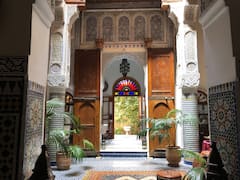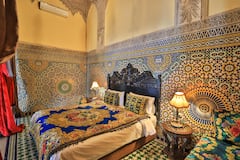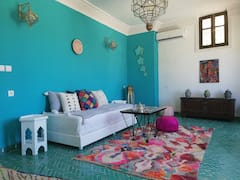Fez is now the second city of Morocco but it was in fact its capital until 1925. The city has two old medina quarters but the largest and most famous is the Fes el Bali. The walled city is listed as a World Heritage Site and is one of the world’s largest urban car free zones. You will see donkeys and men pushing and pulling huge carts up and down the hilly streets of the medina. You will see lots of motorbikes yes, but no cars. The University of Al Quaraouiyine, founded in 859, is the oldest continuously functioning university in the world. The city has been called the “The Mecca of the West” and the “Athens of Africa.” Fez is the country’s cultural and spiritual centre. Officially in North Africa, Fez’s blend of Arabic, French and African culture, make it a satisfyingly exotic multicultural destination
Food in Morocco is very good. My favourite was chicken tagine with prunes and toasted almonds with side dishes of green lentils, Moroccan salad and dark bread. You can get good coffee or freshly squeezed orange juice at every turn, but don’t expect alcohol outside of hotels.
The Medina

If you like the TV show Game of Thrones, you will be in your element in the amazing Medina (walled city) of Fez. More exotic even than the better known Marrakesh, this former capital of Morocco will take you back into the sights, sounds and smells of a medieval way of life, while simultaneously satisfying the cravings of the most addicted shopaholic. If you like beautiful pottery and fabulous handmade Berber carpets, then you will be a happy visitor. Bartering is pretty much compulsory here, and the only way to get good at this is just to get on and have a go. Even when you think you have got something for a ridiculously cheap price, you will still have paid many times what the locals would have, so bear that in mind as you dish out your dirhams.
The medina is a real Aladdin’s cave of things to buy. Gorgeous, colourful bowls, plates, tagines, goblets and pots, some trimmed with silver, abound. Berber silver jewelry, fabulous carpets and tapestries, rich pashminas, argan oil, cedar wood boxes, slippers and spices all spill out into the streets. An ordinary looking door in a wall can open up into a labyrinth of jaw dropping caves packed with the ceramic equivalent of priceless treasure.
Part of the market sells more traditional fare to the locals. Fruit, vegetables and animals are all on offer. Live chickens, ducks and turkeys survey the madding crowd, hopefully unaware of their fate soon to come. You may see a few things being strangled or plucked while still alive so be on your guard.
Most tourist information advises that first time visitors get a guide to help negotiate the maze of criss-crossing narrow streets within the towns ochre walls, but don’t be intimidated. People here are friendly and helpful and it is a lot more fun to explore it by yourself.
The Medina is a UNESCO World Heritage site and one of the best conserved historic towns of the Arab-Muslim world. It is also one of the world’s largest car-free urban areas. As you wend your way through the alleyways you will be passed by men pushing heavily laden carts up stepped cobbled streets, and donkeys, mules and horses all carrying incredibly heavy loads.
The Chouara tanneries in Fez

A top place to visit in the Fez Medina is the famous Chouara tanneries where you can still see leather goods being made in an ancient and traditional way.
Wedged among the ancient buildings and serpentine passageways at the bottom of the Medina is a grid of stone wells, each filled with a different coloured dye. This is an 11th-century tannery that still operates as it did a thousand years ago.
Cow, sheep, goat and camel hides are brought here to be preserved, dyed and turned into the handbags, jackets and wallets sold in the surrounding souks.
The process begins with the raw skins being soaked in a mixture of cow urine, pigeon faeces, quicklime, salt and water—the liquid in the white wells. This loosens the hair from the hides and makes them softer. After a few days of steeping in this concoction, the skins are hauled out and hung from rails on the balconies to dry. Then comes the dyeing. Tannery workers plunge the skins into the coloured wells, leaving them there for a few more days to absorb each hue. The dyes all come from natural substances such as indigo, henna, saffron, poppies and pomegranates.
Due to the dead animal hides and the pigeon poo, the tanneries are a bit of a stinky place and you are given a small sprig of mint to hold under your nose, which I have to say is fairly ineffective. You can’t actually go down into the tanneries where the workers are toiling away in their toxic workplace, but you view them from a nearby shop above. Naturally the shop then takes the opportunity sell you as much as possible!
From Fez to Meknes

Although there is plenty to do in Fez, you can easily take the train to the next city of Meknes, first class, for just a few dollars. Morocco has a very good train system network and some impressive, quite grand, stations. It’s a seven hour train from Marrakesh to Fez but only thirty minutes from Fez to Meknes. The countryside is agricultural and you get a good view of the Atlas Mountains on the journey too.
Meknes was founded in the 11th century by the Berber dynasty of the Almoravids as a military settlement. Later, the Sultan Moulay Ismaïl turned it into an impressive city in Spanish-Moorish style, surrounded by high walls with great doors. The famous grand gate of Bab Mansour has beautiful tile work, carved calligraphy and pillars from nearby Volubilis. Volubilis has the most important and best preserved Roman city remains in Morocco.
The market in Meknes is not as big as the one in the Fez Medina but it is cheaper and you get less hassle. The spice and food market is first class, with towers of multi coloured olives soaked in lemon, meat, fish and spices. I wasn’t so keen on the upside down cow’s heads with their tongues hanging out, but the piles of colourful spices and vegetables are always a draw.
You might be interested in these Airbnbs!
Fez in magical Morocco
The fascinating city of Fez is surrounded by olive groves and gorgeous golden farmland, framed by the Atlas Mountains, giving the backdrop of a biblical landscape — but the Medina remains the beating heart of this unique destination.
Morocco is a magical place; it’s quite a large country. There’s such a lot to see and do that it has to be on my repeat destination list.
In May, the temperature is a perfect 25 degrees C (77 degrees F), although things get much hotter in the summer months. Colourful, vibrant, full of life and character, a trip through Fez’s Medina is like live street theatre every day, and you are both the audience and a player on the stage. I heartily recommend it as an antidote to the ordinary.
History
Get Trip101 in your inbox
Unsubscribe in one click. See our Privacy Policy for more information on how we use your data




















Create an account to